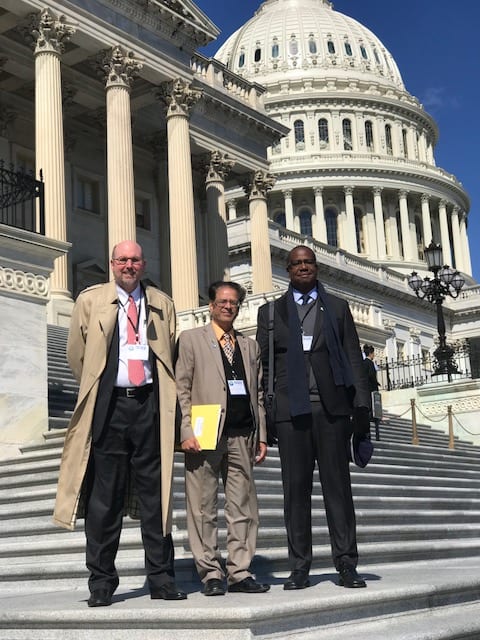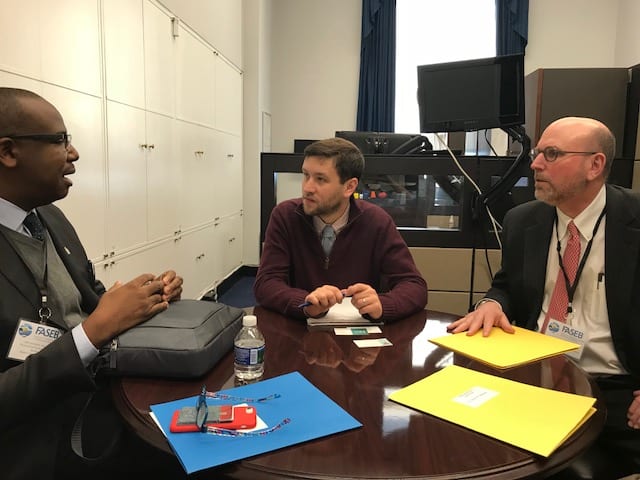Posted by: Neil Hanchard, MD, PhD, ASHG Board Member
I don’t consider myself to be particularly ‘political’; however, the last two Presidential budgets have included closing the U.S. Department of Agriculture-funded building that houses my lab and office. This has made me keenly aware that the science we do doesn’t occur in a vacuum. I thus consider myself particularly fortunate to have had the opportunity to participate in FASEB’s Capitol Hill Day (March 8) as a representative of ASHG. This now annual event brings scientists from across FASEB’s 31 experimental biology societies – including ASHG – to the Capitol to lobby for their own science. It’s timed to coincide with annual budget making season and, since it’s been going on longer than any of the more than 50 fellow scientists in the room knew for sure, it’s a central piece of FASEB’s public policy engagement.

For me, getting up close and personal with the machinations that enable the science engine was a truly fascinating experience. The DC-based staff of FASEB and ASHG essentially do this all the time and, accordingly, were like a well-oiled sequencer. They did an amazing job of prepping first time scientists-come-lobbyists (like myself) – hosting prep sessions well before the event, as well the night before and morning of. Plus, they ensured that everyone was suitably armed with critical talking points for their State representatives and glossy summary pamphlets to go along with them. After a day running around (literally) meeting with State representatives’ aides in the halls and offices of the National’s Capitol, here are my top 5 takeaways:
- There is strength (and comfort) in numbers. FASEB represents ~130,000 scientists in the U.S. and around the world – that’s not a trivial number and the powers-that-be know it.
- The Capitol is very large. It’s a mind-boggling maze of offices and hallways, with a subway linking the two houses to boot. With multiple 10-15 minute meetings strewn across the “The Hill”, there’s no way we could have done it on our own – the FASEB facilitators, who included our own ASHG staff, knew not only where we were going, but each of the representatives’ voting and stances on science issues as well.
- There is an art to the lobby. There’s an etiquette to lobbying, with polite, often unwritten rules of how to deal – the mandatory exchange of business cards (which I forgot – whoops!); the pitch, the pivot (when you’ve lost your audience); the parting promises and closing invitations – a well-rehearsed dance that, performed well, can be the difference between a “yea” and a “nay”.
- Everyone wants their piece of the pie. The Lobby dance is performed by umpteen groups this time of year – if there’s a group you can think of, they were probably there. For scientists to get the funding they need to continue doing good science, they should remember that “the squeaky wheel gets the grease.”
- Science is bipartisan. Somewhat surprisingly for me, the pitch for NIH, NSF, and USDA science was well-received at all of the Texas representatives’ offices we visited, irrespective of party affiliation. I also learned of several unheralded champions for science from both sides of the political aisle.

All in all, this was a truly enlightening and emboldening experience; honestly, if I can do it, pretty much anyone can, and there’s a strong argument that any and all scientists should – host a representative in your lab, visit your local representative’s office, make the phone call/sign the email – as jaded as I was about the process at the start, it was heartening to know that it can actually make a difference.
Neil Hanchard, MD, PhD, FACMG, serves as Early-Career Member of the ASHG Board of Directors. He is an Assistant Professor and Clinical Geneticist at Baylor College of Medicine and Texas Children’s Hospital, and has been a member of ASHG since 2010.
